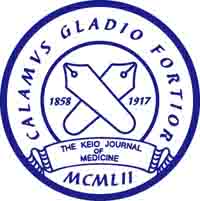[Published online The Keio Journal of Medicine Vol.68, 87-94, by J-STAGE]
<Title:> Incidence, Clinical Characteristics, and Long-term Outcome of the Dilated Phase of Hypertrophic Cardiomyopathy
<Author(s):> Yoshiyasu Aizawa, Yoko Tanimoto, Yoshiko Hirata, Taishi Fujisawa, Ryoma Fukuoka, Kazuaki Nakajima, Yoshinori Katsumata, Takahiko Nishiyama, Takehiro Kimura, Shinsuke Yuasa, Takashi Kohno, Shun Kohsaka, Mitsushige Murata, Yuichiro Maekawa, Yoshiko Furukawa, Seiji Takatsuki, Keiichi Fukuda
<Corresponding author E-Mill:> yoshiyaaizawa-circ(at)umin.ac.jp
<Abstract:> Some patients with hypertrophic cardiomyopathy (HCM) develop systolic dysfunction, called the dilated phase of HCM (d-HCM), which is associated with increased morbidity and mortality. We conducted a retrospective study using an HCM database to clarify the incidence, clinical characteristics, and long-term outcomes of d-HCM. We analyzed an HCM cohort consisting of 434 patients (273 with apical HCM and 161 with non-apical HCM; 18 had obstructive HCM, 16 had dilated HCM, and 127 had other HCM) diagnosed by echocardiography in our hospital between 1991 and 2010. The follow-up period was 8.4 ± 6.7 years. The mean age at final follow-up was 67 ± 14 years, and 304 patients (70%) were men. The mean age of the 16 d-HCM patients at the initial visit was 45 ± 17 years, the age at final follow-up was 59 ± 18 years, and 13 were men. Thirteen d-HCM patients developed atrial fibrillation and six patients developed ischemic stroke. Twelve d-HCM patients were implanted with cardiac devices: one pacemaker, nine implantable cardioverter-defibrillators, and two cardiac resynchronization therapy with defibrillator. Five patients died of progressive heart failure at the age of 61 ± 23 years. The age at the initial visit and final follow-up were lower and the NYHA class, brain natriuretic peptide levels, and left ventricular function at initial evaluation were worse in the d-HCM group. Univariate analysis demonstrated that a lower age at the initial visit was associated with d-HCM (hazard ratio 0.955/1 year increase; 95% CI 0.920 0.991, P = 0.015). In our HCM cohort, the incidence of d-HCM was 4%. A high prevalence of atrial fibrillation and cerebral infarction and poor prognosis were noted in this group, despite patients undergoing medication and device implantation.
<Keywords:> hypertrophic cardiomyopathy, systolic dysfunction, dilated phase, prognosis
<URL:> https://www.jstage.jst.go.jp/article/kjm/68/4/68_2018-0004-OA/_html


![Network Approaches to Uncover Pathogenesis and Therapeutic Targets of Inflammatory Bowel Diseases [Published online Keio J Med, 72, 29-43, by J-STAGE]](http://kjm.pupu.jp/blog/wp-content/uploads/2023/06/2022-0015-IR-100x100.jpg)
![Percutaneous Tendon Needling without Ultrasonography for Lateral Epicondylitis [Published online Keio J Med, 69, 37-42, by J-STAGE]](http://kjm.pupu.jp/blog/wp-content/uploads/2020/06/2019-0004-OA-100x100.jpg)
![Vertebrate Neural Stem Cells: Development, Plasticity, and Regeneration [Published online Keio J Med, 65, 1-15, by J-STAGE]](http://kjm.pupu.jp/blog/wp-content/uploads/2016/03/2015-0005-IR-100x100.jpg)
![A Heart-shaped Sleeve Simplifies Intramedullary Tibial Nail Insertion when Using the Suprapatellar Approach [Published online in advanced , by J-STAGE]](http://kjm.pupu.jp/blog/wp-content/uploads/2017/07/2017-0001-OA-100x100.jpg)
![Selected Topics Relating to Functional MRI Study of the Brain [Published online Keio J Med, 68, 73-86, by J-STAGE]](http://kjm.pupu.jp/blog/wp-content/uploads/2019/12/2018-0011-OA-100x100.jpg)
![Brain machine Interface (BMI)-based Neurorehabilitation for Post-stroke Upper Limb Paralysis [Published online in advanced , by J-STAGE]](http://kjm.pupu.jp/blog/wp-content/uploads/2022/06/2022-0002-OA-100x100.jpg)
![The Efficacy of Transcorneal Electrical Stimulation for the Treatment of Primary Open-angle Glaucoma: A Pilot Study [Published online Keio J Med, 67, 45-53, by J-STAGE]](http://kjm.pupu.jp/blog/wp-content/uploads/2018/09/2017-0015-OA-100x100.jpg)
![Identification of B.1.346 Lineage of SARS-CoV-2 in Japan: Genomic Evidence of Re-entry of Clade 20C [Published online in advanced , by J-STAGE]](http://kjm.pupu.jp/blog/wp-content/uploads/2021/04/2021-0005-OA-100x100.jpg)
![Percutaneous Tendon Needling without Ultrasonography for Lateral Epicondylitis [Published online in advanced , by J-STAGE]](http://kjm.pupu.jp/blog/wp-content/uploads/2019/07/2019-0004-OA-100x100.jpg)
![Regenerative Therapy for Patients with Congenital Heart Disease [Published online Keio J Med, 68, 29-38, by J-STAGE]](http://kjm.pupu.jp/blog/wp-content/uploads/2019/06/2018-0002-IR-100x100.jpg)